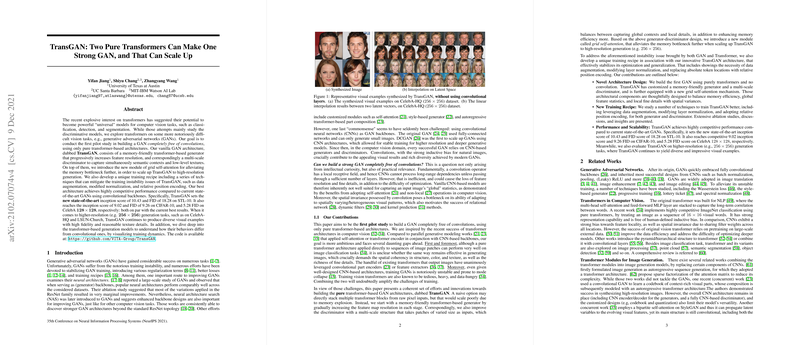Overview of TransGAN: Transforming GANs with Pure Transformers
The paper "TransGAN: Two Pure Transformers Can Make One Strong GAN, and That Can Scale Up" presents an innovative exploration of using transformer architectures in place of convolutional neural networks (CNNs) for generative adversarial networks (GANs). The research seeks to establish a framework for creating GANs that do not rely on convolutions, focusing entirely on transformer-based architectures. Named TransGAN, this approach delineates substantial adjustments in architecture, alongside novel training methodologies to mitigate inherent challenges.
Key Contributions
Transformer-based Architecture: The paper introduces a memory-efficient, transformer-based generator which incrementally refines feature map resolution. Correspondingly, it presents a multi-scale discriminator to effectuate a balance between capturing semantic contexts and ensuring texture detail fidelity. This shift away from convolution-heavy mechanics is further facilitated by the implementation of grid self-attention, designed to address memory constraints during high-resolution image generation.
Training Techniques: The paper also innovates on the GAN training front, introducing a unique methodology incorporating data augmentation, modified normalization processes, and relative position encoding. These enhancements address GANs' notorious training instability, especially when layered with transformer architectures.
Numerical Results
TransGAN is shown to be highly effective, evidenced by its performance on benchmark datasets. It achieves an inception score of 10.43 and FID of 18.28 on STL-10, surpassing current leading GANs using CNN backbones. Similarly, it records an inception score of 9.02 and FID of 9.26 on CIFAR-10, and a FID of 5.28 on CelebA at a 128x128 resolution. These metrics are indicative of TransGAN’s proficiency in generating diversified and high-fidelity synthetic images.
Architectural Innovations
- Generator Design:
- Utilizes a stacked transformer block configuration, progressively increasing resolution.
- Incorporates grid self-attention to efficiently handle larger input sequences without overwhelming computational resources.
- Discriminator Structure:
- Introduces a multi-scale approach allowing patch-level inputs of differing sizes across various stages. This design ensures extraction of both global and local textures.
Implications and Future Directions
The theoretical significance of this work lies in challenging the conventionally accepted notion that CNNs are indispensable for image generation tasks in GANs. By employing transformers, the paper opens potential avenues for exploring long-range dependencies and more global contextual relationships in image data. Practically, this transformation holds promise for scaling generative models to increasingly higher resolutions while retaining quality and computational feasibility.
Future explorations may take this foundational work further into domains requiring ultra-high-resolution synthesis or where dataset sizes are significantly larger, leveraging transformers' capability to model extensive correlations. This research—by establishing a clear method for integrating transformers into GAN frameworks—sets a precedent for leveraging modern transformer advantages in generative modeling, potentially leading to more adaptable and robust AI applications in visual synthesis.
In conclusion, this paper offers a substantial contribution to the exploration of GAN architecture, applying a purely transformer-based framework to achieve significant results. The insights gained from TransGAN not only enhance our understanding of generative models but also invite future exploration into their scalable applications across various domains.
